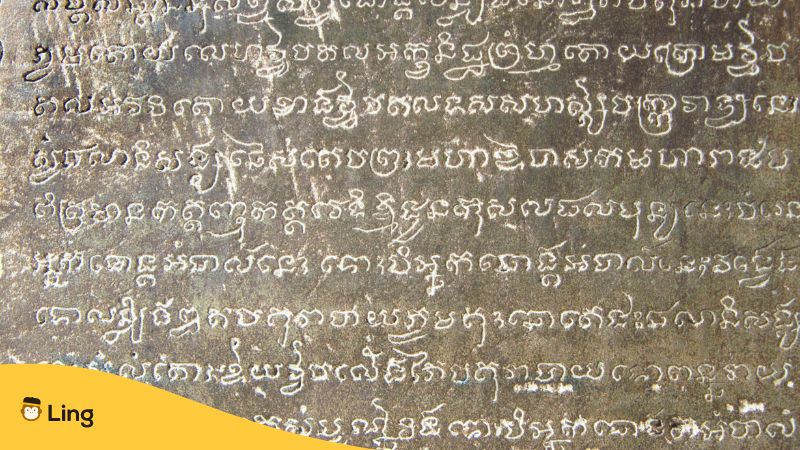Have you ever felt the thrilling exhale when the last puzzle piece fits perfectly into place? That’s the exact feeling you’ll get as you master the intricacies of Khmer grammar. Hidden in the mysterious temples and bustling markets of Cambodia is a rich language waiting to be explored. And guess what? You no longer need to buy a plane ticket to experience it.
Welcome to our guide on mastering Khmer grammar, your one-stop destination to decode the essence of this ancient language! In this guide, we’ll be exploring the ins and outs of Khmer grammar, from basic sentence structure to more complex concepts like verb tenses and word order. Whether you’re a beginner looking to get started or an experienced learner looking to fine-tune your skills, this guide has something for everyone.
Khmer Grammar Fundamentals
Let’s take a fun and fascinating trip into the unique world of the Khmer language! From its enchanting alphabet to the beautiful blend of consonants and vowels, we will encounter new concepts and inspire a love for learning this rich and challenging language. Get your explorer cap on. It’s time to jump into Khmer!
The Khmer Alphabet
Now if you’ve been around the language block a few times, you might be used to the classic 26 letters of the English alphabet. Well, hold onto your hats because Khmer is about to blow your socks off! You see, the Khmer alphabet is packed to the brim with all unique 33 consonants and 24 vowels, making it the longest alphabet in the world. Talk about grandeur!
Consonant Sequences: The Khmer Word Building Blocks
If the alphabet is the backbone of the language, consider consonant sequences as the playground where all the fun learning happens.
In Khmer spelling, consonant sequences take center stage in crafting words. They are formed by combining basic letters in different ways – something like a word jigsaw puzzle. It’s like playing a game – each piece slides into another, fitting perfectly as if it’s telling us, “Hey, now we’re speaking Khmer!”
Subscripts: Tiny But Mighty
Subscripts are your secret weapons for mastering Khmer. These little letters may be small, but they are mighty, contributing significantly to the beauty and complexity of the Khmer language. In Khmer, some consonants can descend below the line, transforming into subscripts that partner with a preceding base consonant. They’re kind of like friendly sidekicks, providing support and enhancing the meaning of each word!

Forming Khmer Sentences
Discovering how to structure sentences in Khmer is like gaining the key to exciting conversations, and it’s more fun than you think!
So, how do we structure a sentence in Khmer? Generally, It’s “Subject – Verb – Object” or the usual grammatical position. And the modifiers – adjectives, demonstrative, numbers, etc. – they just chill out after the nouns.
One thing to remember is this: changes in word order could change the whole meaning. So, just as in life, order matters.
Khmer Nouns
Now, let’s tackle Khmer nouns – those all-important words we use to label just about everything in our world.
Kinds Of Khmer Nouns
In Khmer, we split nouns into two big families:
- Proper nouns (neam pitabrakad or នាមពិតប្រាកដ), such as Phnom Penh or Angkor Wat. They’re like the names of your friends—they’re unique, memorable!
- Common nouns (neam ry tes or នាមរយៈទេស), like phteah (ផ្ទះ) which means house, or lan (ឡាន) which means car. They are the everyday objects or concepts you interact with.
No Gender
Take a deep breath now because this might just make you jump with joy! In Khmer, nouns do not have genders. That’s right – you don’t need to worry about assigning masculine, feminine, or neuter tags to nouns like in other languages. Everything is nice and neutral!
No Articles
Unlike English with “a,” “an,” and “the” Khmer does away with articles. The context of the phrase helps you to understand whether you are referring to a specific thing or not.
Plural Nouns In Khmer
Now, here comes a real game-changer. You know how in English we stick an ‘s’ at the end of a noun to make it plural, like ‘cat’ turns into ‘cats’? Well, hold onto your hats because, in Khmer, there’s no such thing! Yes, you heard it right, no plural nouns. In Khmer, whether you’re talking about ‘one apple’ (trəy) or ‘many apples’ (trəy), the word stays the same.
Isn’t that just a sigh of relief? So, next time, when you are in a Cambodian market, just remember, whether you want one fruit (l’hɨw) or several (l’hɨw), the word is still the same.
The Magic Of Context
Khmer is an analytic language. Hence, understanding the meaning of nouns in Khmer is a little like detective work. You need to sniff out clues from the context. In Khmer, whether a noun is singular or plural, it all comes down to the setting. So, keep those eyes peeled and context in mind!

Khmer Verbs
Here’s a nugget of joy: In Khmer, there’s no past tense, present tense, or future tense, as you know it in English. I can already feel your relief, my friend!
Instead, Khmer uses aspect markers to give the verb its ‘life’ in time. So, whether you plan on telling your friend about the fantastic new dish you tried yesterday, sharing what you’re up to right now, or making future plans – it’s all about context and knowing the right markers.
So, understanding Khmer’s verb system boils down to recognizing these markers. Some common aspect markers include បាន (baan) for completed actions and កំពុង (kompung) for ongoing actions.
Conjugation
Now, talk about tweaks and turns. Brace yourselves because Khmer doesn’t use conjugation. This might sound a bit crazy at first, but actually, it makes things easier. Your auxiliaries aren’t changing forms as they would in other languages.
In Practice: Using Khmer Verbs
Let’s look at an example sentence to get a more precise hold of Khmer verbs.
- “យើងកំពុងសរសេរអត្ថបទ” (Yeung kompung sros atthbak)
Here, “សរសេរអត្ថបទ” (sros atthbak) means ‘write an article,’ while “កំពុង” (kompung) is the ongoing aspect marker. Thus, the whole sentence translates to “We are writing an article.”
Piece of cake, right?
Khmer Adjectives, Adverbs, And Comparatives
Now, let’s dive right into the sweet sauce of the Khmer language: adjectives, adverbs, and comparatives.
Unpacking Adjectives
So, what’s an adjective, you ask? Imagine you’re chatting with a friend about the most delicious dish you’ve just tasted. “Delicious” here is an adjective because it adds some flavor to your dish, quite literally! In Khmer, adjectives typically come after the word they’re describing. Let’s look at an example:
- ផ្លែឈើ (pla chher): sour fruit. See how “chher” comes after “pla”? That’s an adjective in action!
All About Adverbs
Next, we have adverbs. If you think of adjectives as the spices for nouns, adverbs are the condiments for verbs. They tell us ‘how’ something is done, like quickly, slowly, or joyfully. In Khmer, just like in English, adverbs can jazz up your sentences. Here’s an example:
- ខ្ញុំរហ័សចិត្ត (khnhom rahoss chet): “I quickly like”. In Khmer, the action (like) comes before the adverb (quickly).
Understanding Comparatives
Finally, let’s chat about comparatives. They do exactly what you think: compare stuff. “Better,” “faster,” “more attractive” – they’re all comparatives. But, here’s a little secret: Khmer takes comparatives and makes them a simple game. No complicated changes – just add a word in front!
- ច្រើនជាង (chreun chiang): more than.
- តិចជាង (tchich chiang): less than.
If you wanted to say, ‘My dog is bigger than your dog,’ you’d say:
- ឆ្កែរខ្ញុំជាងឆ្កែរអ្នកធំ (Chgai Knhom Cheang Chgai Nek Thom).

Asking And Answering Questions In Khmer
Let’s get down to business with one of the most important aspects: asking and answering questions. Once you’ve got this down, you’ll be chatting away with confidence in no time!
The Basics: What Are We Questioning?
Before we get down to business, we need to understand the fundamentals: what, where, who, when, why, and how.
| English | Khmer | Roman Transcription |
|---|---|---|
| What | អ្វីខ្លះ | Awrei klah |
| Where | ណាំងណា | Nae-amna |
| Who | បងណា | P’ongna |
| When | ពេលណា | Pehl-na |
| Why | ហេតុអ្វី | Het awrei |
| How | របៀបណា | Ra-bip-na |
Now that we have those handy dandy basics covered, let’s forge ahead!
Asking Questions
In Khmer, forming questions is a piece of cake! Here’s the recipe:
- Start with the question word (if needed).
- Add the subject (who or what is doing the action).
- Continue with the verb (the action itself).
- End with the question particle “ទេ” (te) – this little buddy tells everyone you’re asking a question!
Let’s check out some examples.
| English | Khmer | Roman Transcription |
|---|---|---|
| What is your name? | តើឈ្មោះអ្នកគឺជាអ្វីទេ? | Tae chmouh anak kuih chea awh te? |
| Where do you live? | អ្នករស់នៅណា? | Anak rok now nea? |
| When is the party? | ពេលណាក្រុមហ៊ុនយើង? | Pel nea krom-hun yeung? |
Answering Questions
Answering questions is equally easy-peasy! First, provide the answer, and then follow it with any additional information. Let’s practice with our previous examples.
| English | Khmer | Roman Transcription |
|---|---|---|
| My name is _______ | ឈ្មោះខ្ញុំគឺ ______ | Chmouh khnhom kuih _______ |
| I live in ________ | ខ្ញុំរស់នៅ ______ | Khnhom rok now ______ |
| The party is on ___________ | ក្រុមហ៊ុនយើងនៅលើ _________ | Krom-hun yeung now lei ________ |
Politeness And Formality In Khmer Grammar
We’ve got a bit of a cultural journey ahead of us too, as proper grammar and politeness in Khmer are deeply intertwined. You know, it’s not all about throwing words together! It’s about balancing the beauty of communication with the subtle art of respect.
The Art Of Communication, The Khmer Way
In the land of beautiful temples and delicious Amok, people enjoy politeness just as much as they do a good street food feast. But how does this politeness find its way into Khmer grammar, you ask?
- Hierarchy Matters: Khmer is a language where your conversation partner’s social status affects the words you choose. Say there’s a dedicated word for ‘eat’ depending on whether you are addressing the King or your BFF. Isn’t that intriguing?
- The Respectful Distance: Pronouns in Khmer change based on the level of formality and the intimacy of your relationship with others. If you think of English pronouns as a buffet, Khmer pronouns are an infinite feast! More to learn, more to love.
Tiers Of Politeness
The Khmer language has three main levels of politeness. Here’s a quick breakdown:
- Informal: You’ll use this with close friends and family.
- Polite: Perfect for conversations with acquaintances or strangers.
- Formal: Reserved for more serious situations or when addressing someone of higher social status.
Now let’s go a bit deeper!
Informal Chitchat
To keep things casual, simply use a person’s given name when speaking with them. For instance, you can say, “Hi, Lina!”, and you’ll be golden. Make sure to only apply this style when you’re BFFs or super comfy with someone, alright?
Don’t overthink this one—just be yourself and have fun!
Friendly Yet Polite
It’s always good to show a little more respect when meeting someone new or talking with an acquaintance. In this case, add “បង្អួច” (bong) for males and “ប្អូន” (oun) for females, before their name. It’s kinda like saying “brother” or “sister”! Here’s an example:
- For a male: បង្អួចភីសា (Bong Piseth)
- For a female: ប្អូនសុខុំ (Oun Sokhom)
Nicely done! You’re showing that you’re friendly while also being respectful. What a superstar!
Putting On The Formality
When it comes to formal contexts or higher-ups, we don’t joke around! Use the title “លោក” (lok) for men and “លោកស្រី” (lok srei) for women. For example:
- For a male: លោកឆាន់ (Lok Chan)
- For a female: លោកស្រីសុខាក់ (Lok Srei Sokha)
Get ready to impress with your polite and respectful language skills—high-fives, everybody!
Polite Speech Finishers
Khmer also has some specific words called sentence finishers that help convey politeness. You’ll see them at the end of sentences, like cute little tails:
- “ខ្ញុំ” (knhom): Use it when you’re making a request or asking for a favor, like “Can you pass me the salt, please?” (Tip: Raise your voice slightly when saying this one!)
- “ណា” (na): Adds a hint of formality when making statements or asking questions. Try it out with something like, “Where’s the bank, please?”

Let’s Conquer Khmer!
So, we’ve traversed through the breathtaking trails of Khmer grammar, haven’t we? It’s been a fabulous trip, full of bending consonants and shifting vowels – like a linguistic roller coaster ride!
Remember, mastering Khmer grammar might seem like scaling Everest at first glance. But let’s not forget – even Everest has been conquered numerous times. What’s important is your persistence and structured learning, your desire to understand the essence of this intriguing language. The best part? You’ve got the ball rolling already with our guide.
Learn Khmer With Ling
Step into a fun, interactive, and immersive language learning experience with the Ling app. Embrace the adventurer in you and explore a world of languages – from Spanish to Korean and beyond – with over 60+ options right at your fingertips.
With the Ling app, every moment becomes an opportunity to grasp a new linguistic skill. Choose the Ling app, your passport to become a global citizen. Join us today on this wonderful expedition of learning and discovery.
Download the app now on the App Store and Play Store!


































































